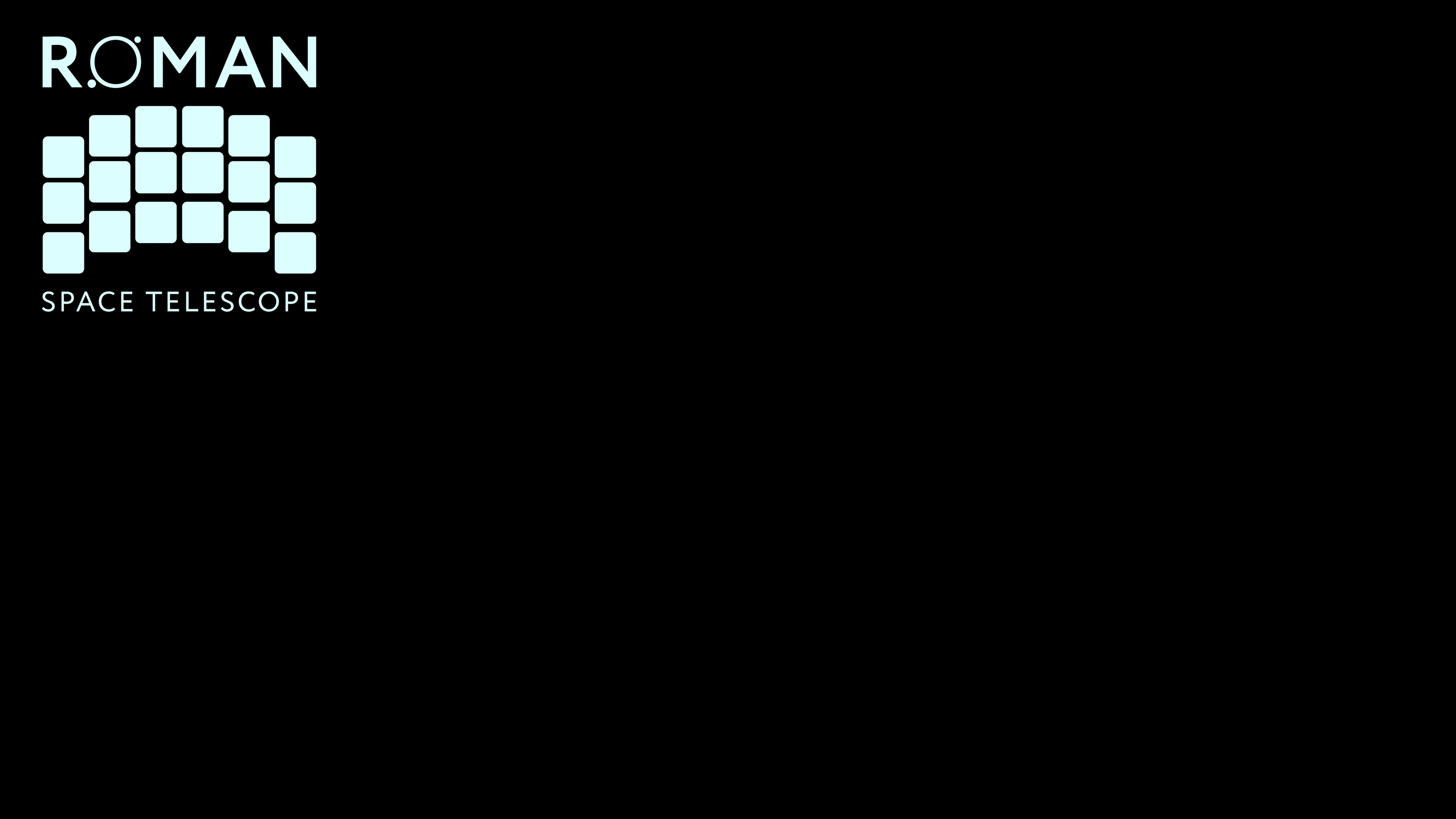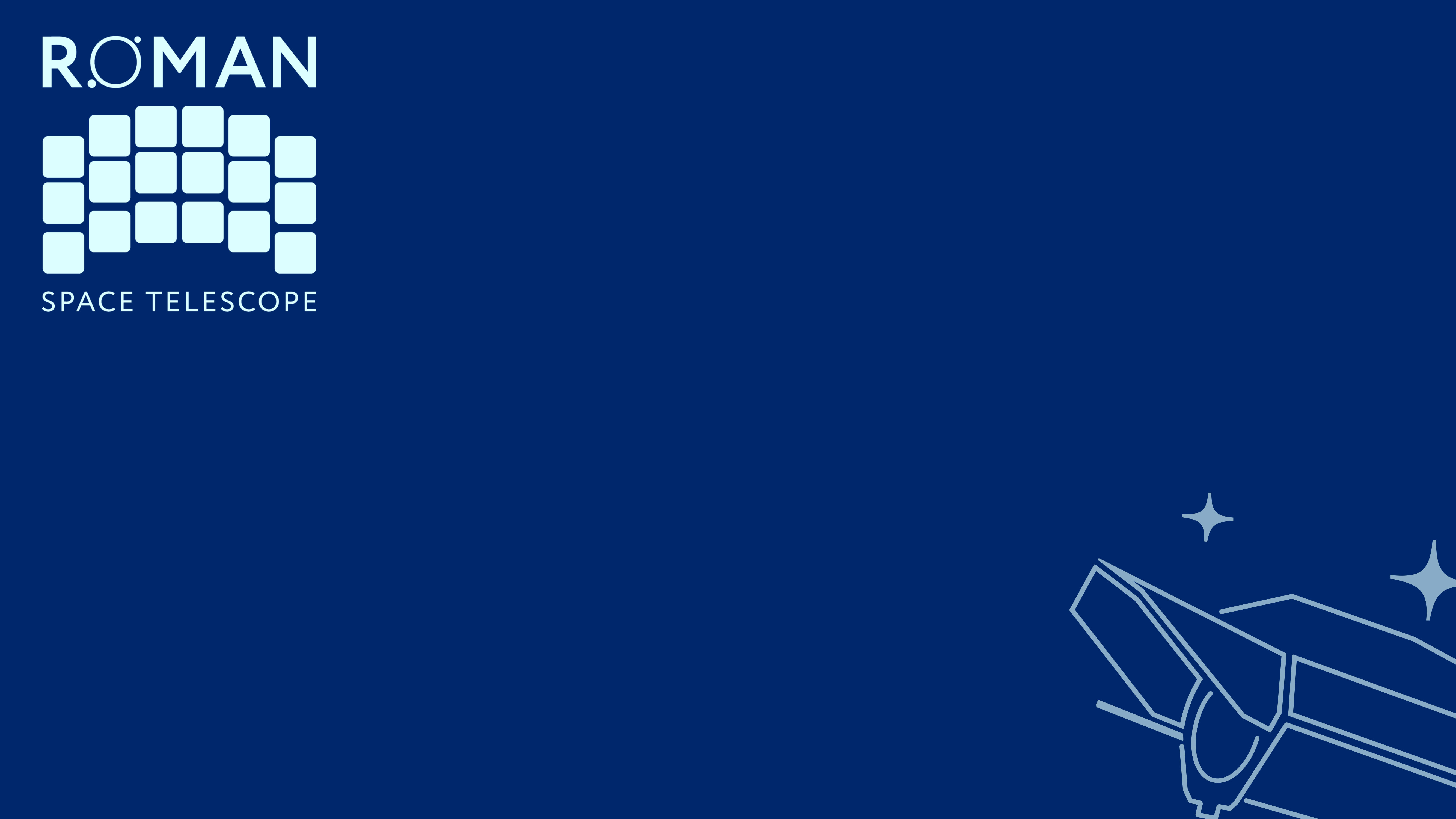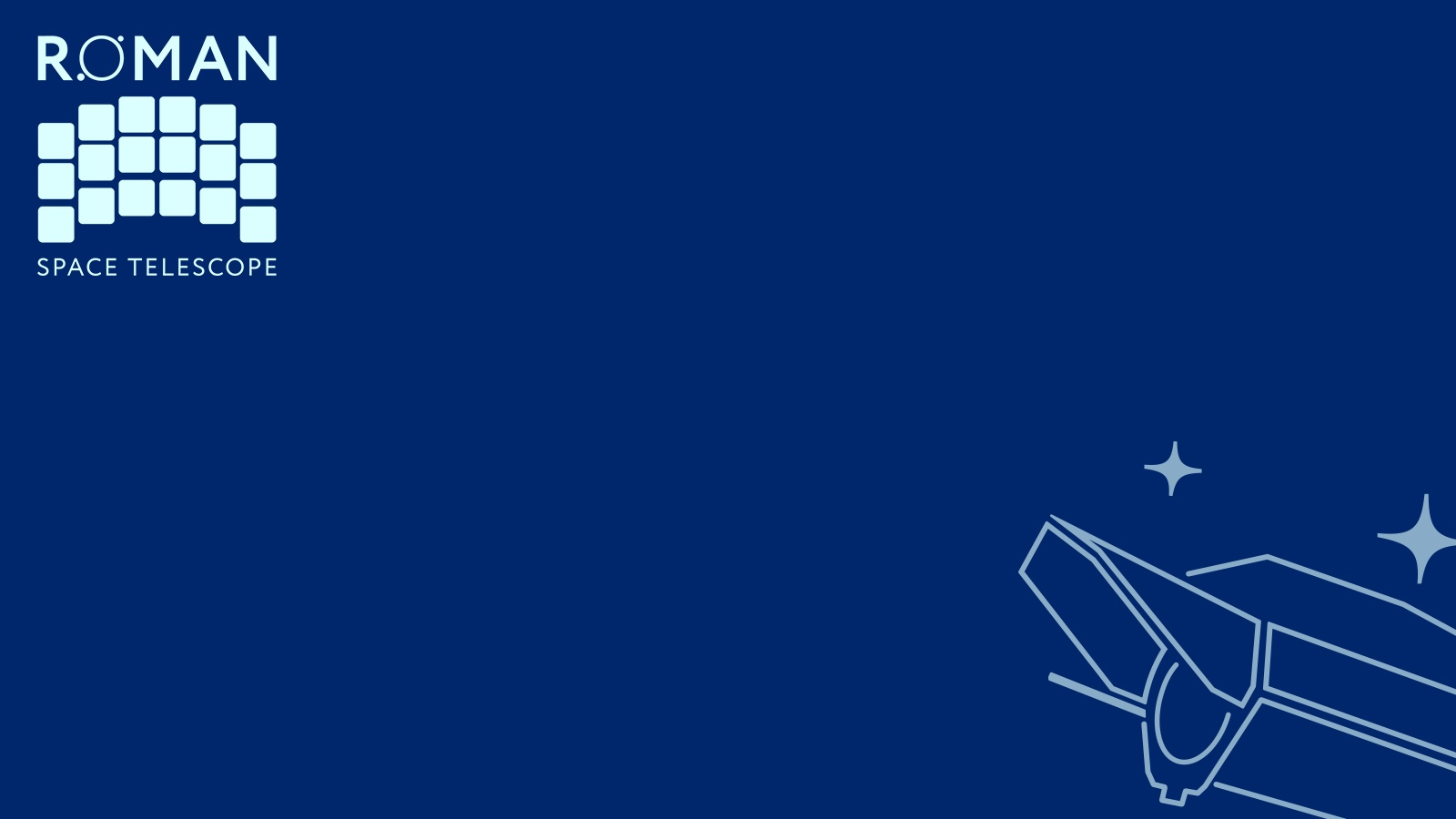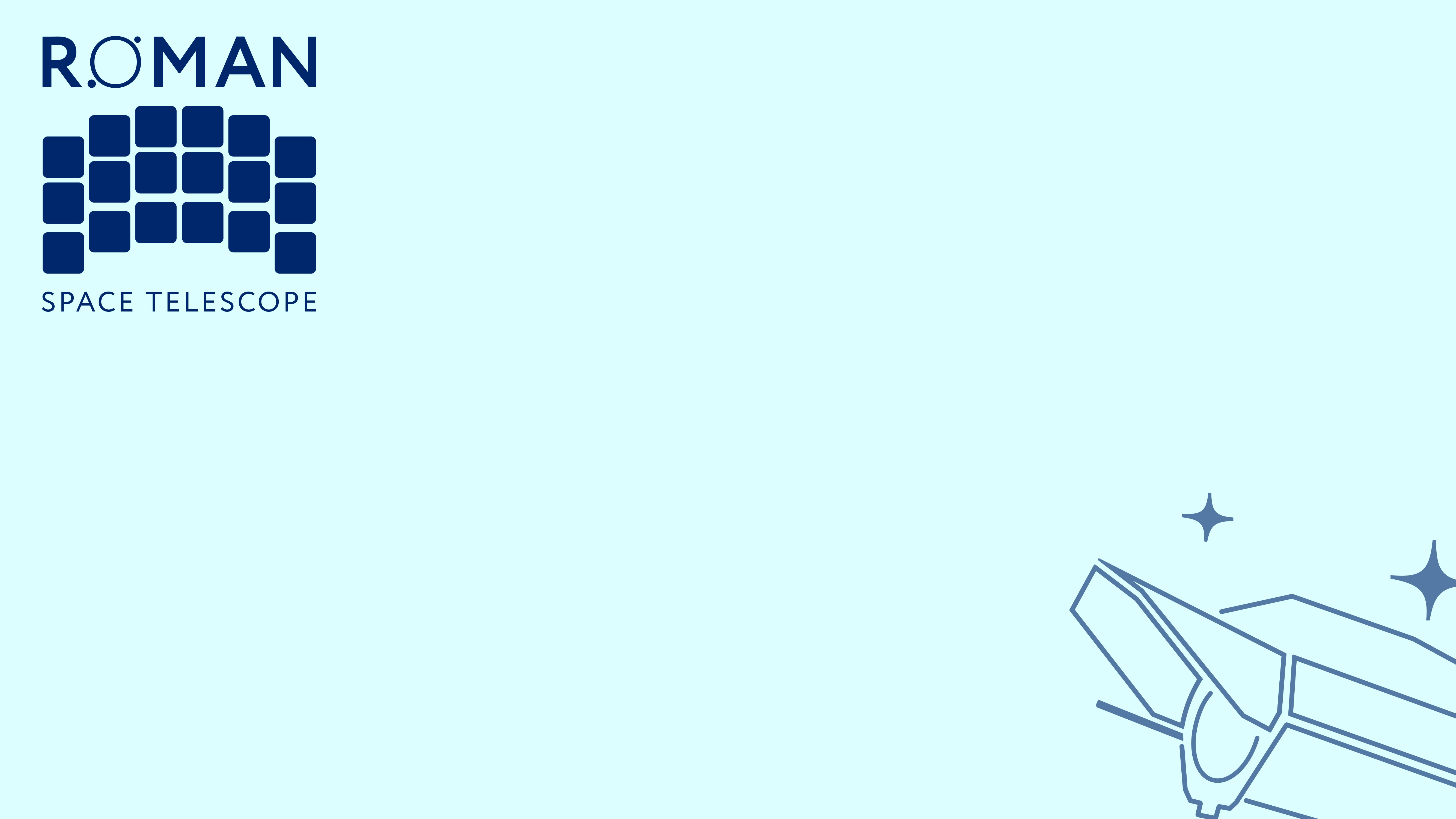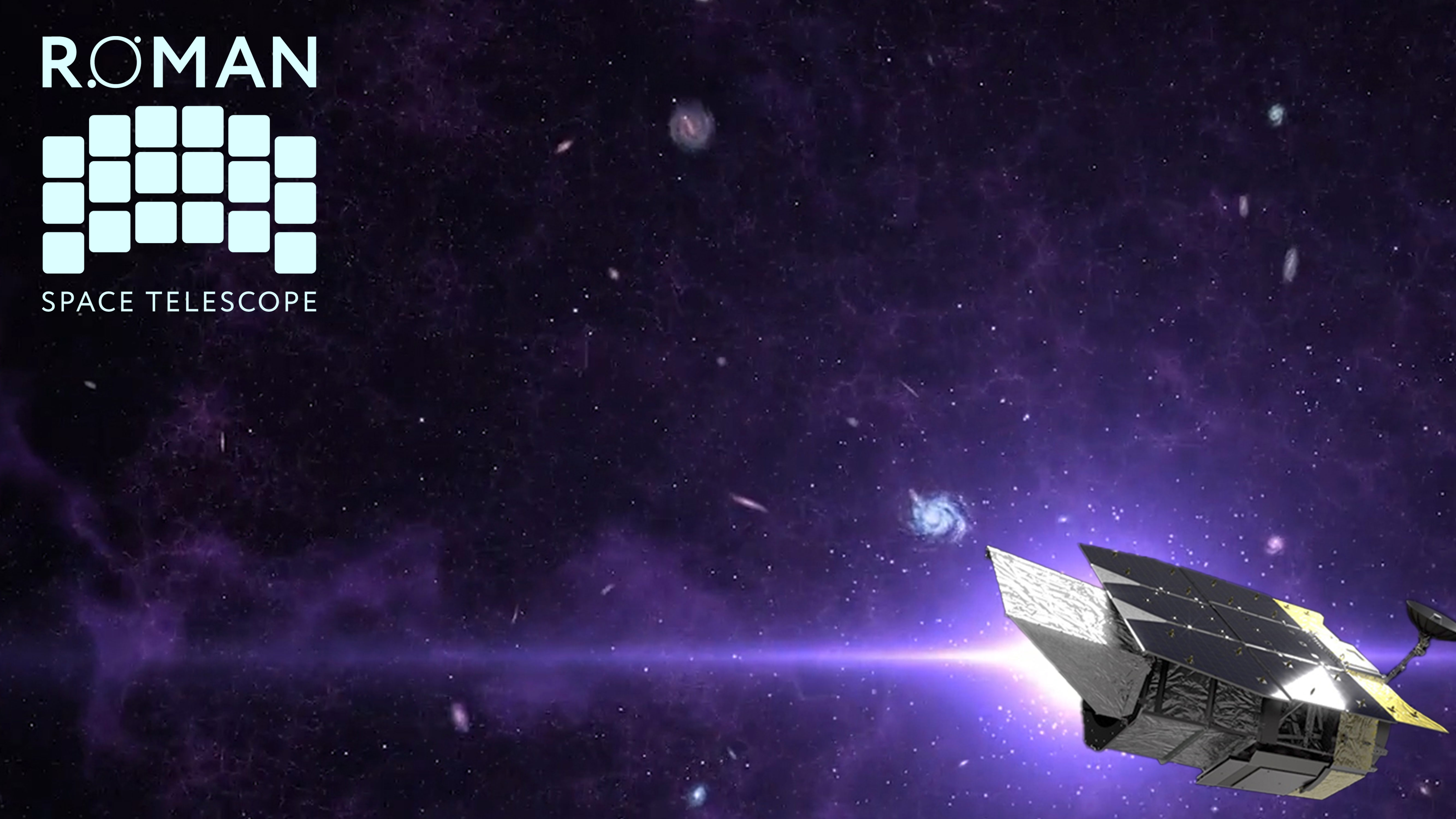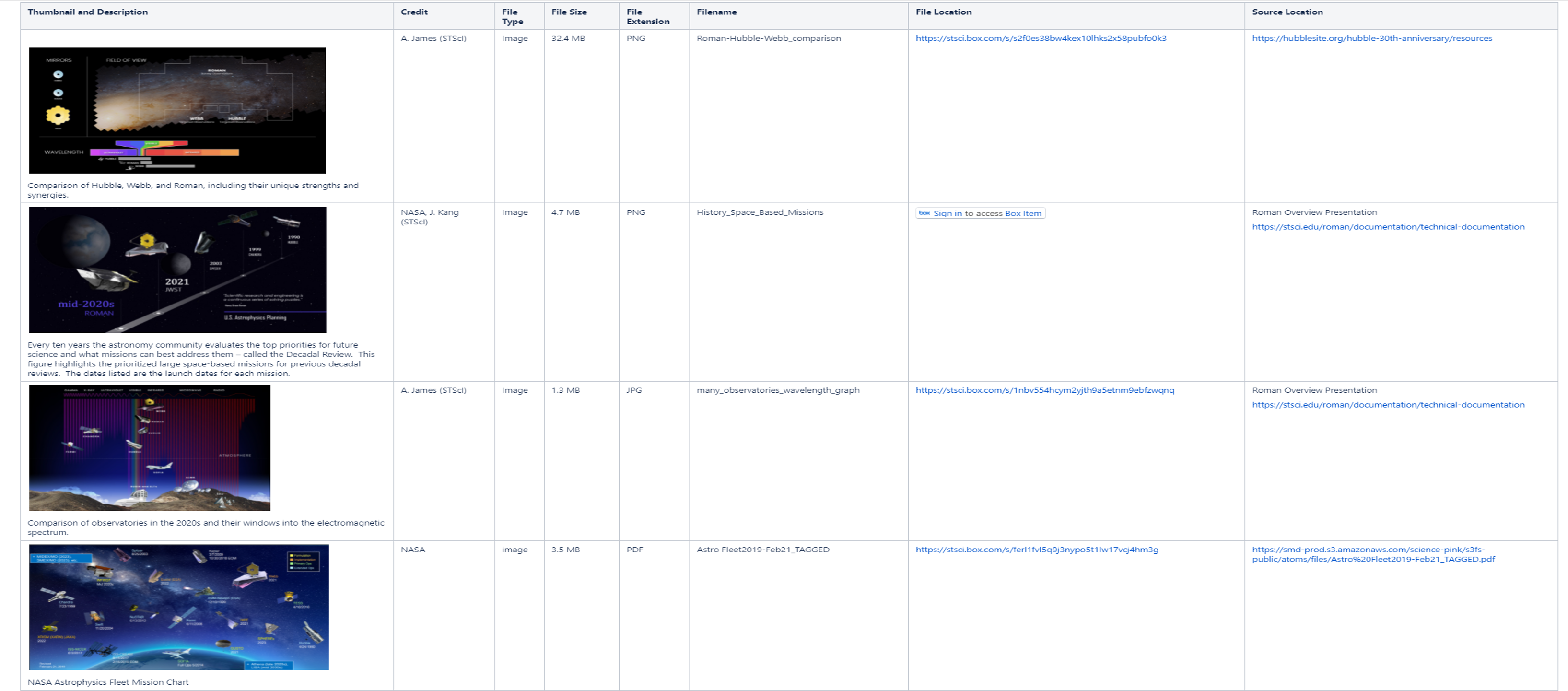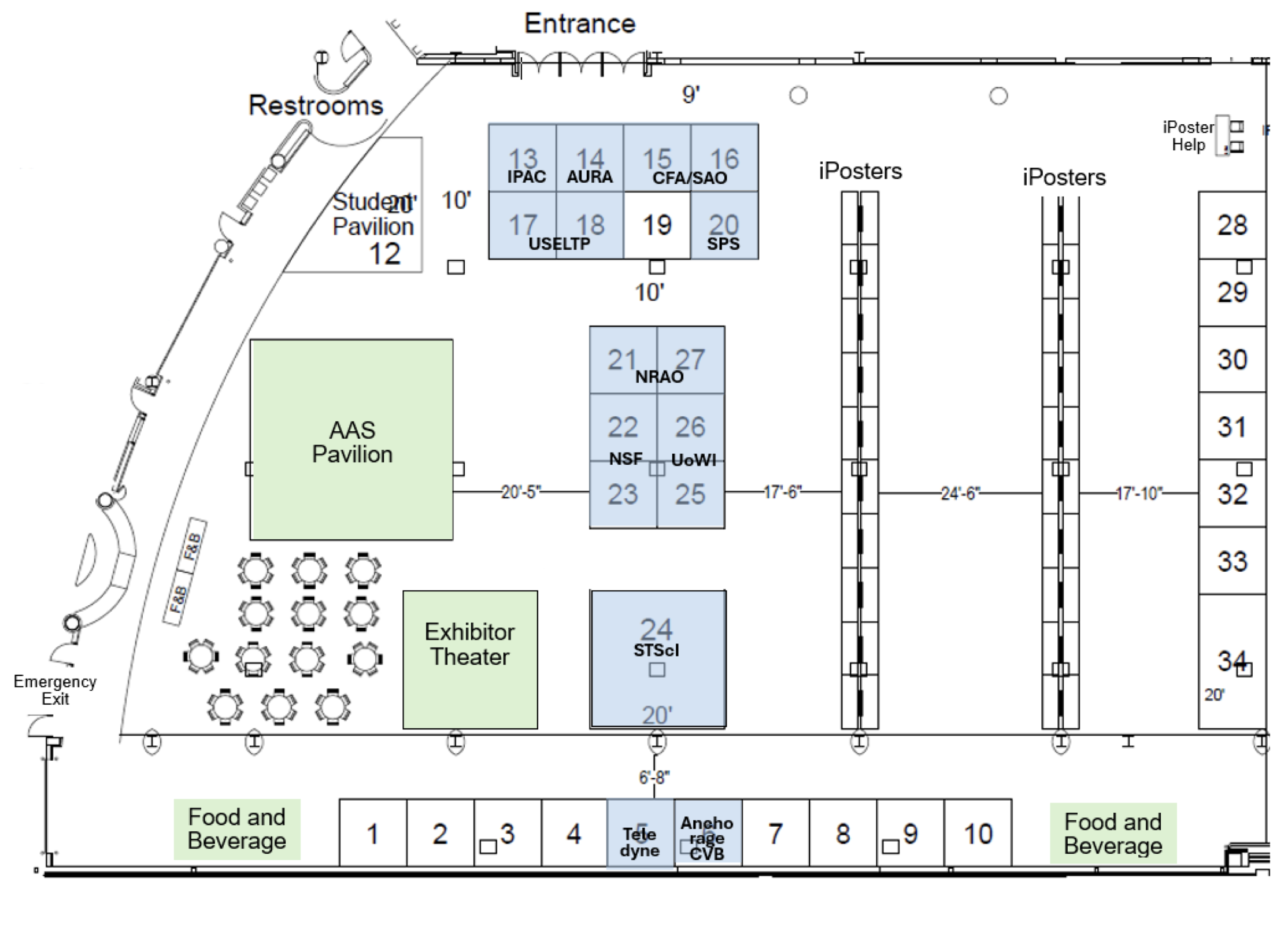Page History
| Content Layout Macro |
|---|
| Infotip | ||
|---|---|---|
| ||
If you are working on press-worthy science that relates to future Roman WFI science, we invite you to share your work with Brandon Lawton - lawton@stsciMartha Irene Saladino - saladino@stsci.edu - Project Education & Outreach Scientist, Roman Science Communications. Brandon Martha I. will be at the STScI booth and will work with the Roman partners to share your exciting science with the world! |
Roman Events at the |
244rd AAS Meeting | ||
Location | ||
|---|---|---|
Title | Date and Time ( |
|---|
CT) | ||
|---|---|---|
iPosters | ||
Room: Exhibit Hall A | iPoster: Roman Space Telescope Observing Program Implementation (127.05) | Monday, June 10, 2024 5:30pm - 6:30 pm |
Room: Exhibit Hall A | iPoster: | Monday, June 10, 2024 5:30pm - 6:30 pm |
Room: | iPoster: ROSALIA: ROman Sky Analyst for Low surface brightness Imaging & Astronomy (129.02) | Monday, June 10, 2024 5:30pm - 6:30 pm |
Room: Exhibit Hall A | iPoster: The Roman Space Telescope Science Operations Center (306.01) | Wednesday, June 12, 2024 9:00am - 10:00am |
Room: Exhibit Hall A | iPoster: Exploring the early universe with future Roman Ultra Deep Field observations (401.01) | Thursday, June 13, 2024 09:00am - 10:00am |
Town Halls | ||
Room: Exhibit HallB | Town Hall: NASA Town Hall | Monday, June 10, 2024 12:45pm - 1:15pm |
Room: Lecture Hall | Town Hall: STScI Town Hall | Wednesday, June 12, 2024 12:45pm - 1:15pm |
Oral Presentations | ||
Room: Exhibitor Theater | Oral Presentation: The Roman Space Telescope Science Operations Center | Wednesday, June 12, 2024 2:00pm - |
Roman Resources | ||||||||||||||||||||||
Welcome to the home for Roman Documentation (RDox)!Documentation for the Roman Space Telescope is currently under construction and subject to change, but represents the most up-to-date information available. | ||||||||||||||||||||||
Roman Community ForumThis is a monthly virtual meeting that provides updates on Roman mission status and plans, and an opportunity for the science community to engage with the Roman Project and Science Centers. | ||||||||||||||||||||||
Roman Virtual Lecture SeriesThe Nancy Grace Roman Space Telescope monthly virtual lecture series is run jointly by JPL, IPAC, Goddard, and STScI. These talks are open to the entire astronomy community and cover science, engineering, and technology related to the Roman mission. All are welcome and encouraged to attend. Talks are ~20 minutes with ~10 minutes for Q/A, and are scheduled for the 3rd Thursday of each month from 1-1:30 pm Pacific / 4-4:30 pm Eastern. | ||||||||||||||||||||||
Roman Science and Technical Overview Brochure
You can also find the brochure here. | ||||||||||||||||||||||
NASA Roman Coronagraph Instrument Fast Facts Sheet
| ||||||||||||||||||||||
Roman Virtual Backgrounds Here are a series or Roman virtual backgrounds you can use in your virtual meetings and presentations.
| ||||||||||||||||||||||
Roman Resources Available at the 242nd AAS Meeting | ||||||||||||||||||||||
Roman Science and Technical Overview Booklet
This 36-page booklet provides a current overview of the scientific capabilities, technical specifications, and operations of the Nancy Grace Roman Space Telescope. It can also be found here. | ||||||||||||||||||||||
Roman Slide Set
This presentation highlights the science that will be enabled by the Nancy Grace Roman Space Telescope. The presentation includes notes for the presenter and can be used as a whole or in parts. It has been updated with accessibility in mind. The presentation comes in multiple formats, found here | . We encourage scientists to take and use any or all of these slides, modified if needed, for your presentations about Roman science. | |||||||||||||||||||||
Roman Visual LibraryThe Roman Visual Library, located here, is a resource for astronomers to grab Roman-related images. You can find images, captions, credits, and image source locations here. | ||||||||||||||||||||||
Roman Brochure
Targeted for launch in late 2026, the Nancy Grace Roman Space Telescope will revolutionize astronomy by building on the science discoveries and technological leaps of the Hubble and Webb space telescopes. The Roman brochure, located here, provides a simple way to express the power of Roman's field of view and is useful for all audiences. |
Come and Find Us in the Exhibit Hall! |
| title | Check out the NASA Hyperwall Talks |
|---|
How to Connect With Us |
|---|
NASA (Booth ???)
The Roman Space Telescope Project Office is at NASA's Goddard Space Flight Center, which also oversees the work on the Wide Field Instrument (WFI), the Spacecraft Bus, and System Integration.
STScI (Booth
???24)
STScI is Roman’s Science Operations Center (SOC). The SOC is responsible for the mission's observation scheduling system, WFI data processing system for the direct-imaging mode and the mission's entire data archive. STScI performed pre-formulation, formulation, and design activities for Roman starting in 2014, and continues its role in science operations system engineering, design, science research support, and scientific community engagement and public outreach.
| Info | ||
|---|---|---|
| ||
The Roman Help Desk is operated joinly by the SOC and the SSC. Contact the SOC helpdesk for questions about SOC tools, WFI imaging, data calibration and archiving, proposal planning and scheduling. |
Caltech/IPAC (Booth
???13)
IPAC is home to the Roman Science Support Center. IPAC is responsible for Roman’s Coronagraph Instrument operations, high-level data processing of grism and prism data from the Wide Field Instrument (WFI), high-level data processing of WFI microlensing survey data and community engagement for Roman exoplanet science and wide field spectroscopy. IPAC will also implement the proposal solicitation and grant management for the General Observer, Guest Investigator and Theory programs, curate telescope instrument and simulation efforts and engage the greater scientific community in preparing for science with Roman.
| Info | ||
|---|---|---|
| ||
The Roman Help Desk is operated joinly by the SOC and the SSC. Contact the SSC helpdesk for questions about WFI spectroscopy, microlensing data processing, the proposal submission and review process, and the coronagraph. |
JPL Exoplanet Exploration Program (Booth ???)
JPL is building Roman’s Coronograph Instrument and is involved with detector validation and developing the coronagraph’s science capabilities. The coronagraph will provide the first in-space demonstration of technologies needed for future missions to image and characterize rocky planets in the habitable zones of nearby stars. By demonstrating these tools in an integrated end-to-end system and enabling scientific observations, NASA will validate performance models and provide the pathway for potential future flagship missions.
| Info | ||
|---|---|---|
| ||
Come by our booth to learn how a coronagraph, an instrument that scientists use to block out a star’s light to directly image the planets orbiting around it, works and will be used on future NASA missions, like the Nancy Grace Roman Space Telescope. |
Ball Aerospace (Booth ???)
NASA selected a diverse team from Ball Aerospace to design and develop the Wide Field Instrument (WFI) Opto-Mechanical Assembly for the Roman Space Telescope mission. Ball is partnered with NASA to support the optical-mechanical assembly, integration and test of WFI. The optical-mechanical assembly, which includes the optical bench, thermal control system, precision mechanisms, optics, and electronics, provides the stable structure and thermal environment that enables the wide field, high quality observations of WFI. Ball's design uses heritage hardware to unfold the incoming light, providing cost and schedule savings to the mission.
Future Conference - Be Sure to Mark Your Calendars! |
|---|
Roman Science Inspired by Emerging JWST Results
Dates
June 20, 2023 - June 23, 2023
Location
Space Telescope Science Institute (STScI)
3700 San Martin Drive
Baltimore, MD 21218
Description
The Nancy Grace Roman Space Telescope, planned to launch in late 2026, will provide a simultaneous field of view 100 times larger than that of JWST, and sensitivity and resolution similar to that of HST. With incredible survey speeds, Roman will perform near-infrared imaging and spectroscopic surveys approximately 1000 times faster than the largest surveys on HST, yielding contiguously surveyed areas rivaling ground-based surveys. With these capabilities, the Roman surveys, both community-defined Core Community Surveys and competed General Astrophysics Surveys, will have broad impacts across all of astrophysics. Furthermore, Roman’s survey capabilities will be highly synergistic with JWST's ground-breaking sensitivity, extended wavelength coverage, and broad range of observing modes. Together, these observatories will operate in tandem not only with Hubble, but also with Rubin, Euclid, other ground-based and space-based facilities of the 2020s. The first year of science from JWST is already providing exciting scientific results on a wide range of topics that are relevant for Roman. We therefore announce a conference at the Space Telescope Science Institute (Baltimore, MD, USA) from June 19-23, 2023 that will focus on how emerging new results from JWST inform the planning for Roman’s surveys, including the science questions the surveys can address and their anticipated scientific yield. In concordance with the broad range of astrophysics addressed by both missions, we welcome contributions on all scientific topics connected to this theme, from solar system objects and exoplanets, to nearby galaxies, to the search for the first stars and galaxies, and everything in between. A writer's workshop will be offered concurrently with the conference.
More Information
How Roman Observations Will Confront Theory
https://conference.ipac.caltech.edu/roman2024/
Dates:
July 9 - 12, 2024
Location:
Caltech/IPAC campus
Description:
The goal of this 4-day conference is to bring together inclusively members of the community to discuss how observations with the Nancy Grace Roman Space Telescope will confront and challenge theories, from exoplanets to the edge of the Universe. The conference will focus mainly on the Core Community Surveys -- the Galactic Bulge Time Domain Survey, High Latitude Wide Area Survey, and High Latitude Time Domain Survey, which will occupy the majority of the primary mission -- as well as the Coronagraph Instrument technology demonstration. However, there are boundless theories that will also be addressed and tested by the wide variety of General Astrophysics Surveys. This conference, to take place on the Caltech campus and online, will be an active and exciting confluence of both observers and theorists to outline the potential breakthroughs that could be made possible during the lifetime of the Roman Space Telescope.
If you have any questions, you can email us at romanssc@ipac.caltech.edu .https://www.stsci.edu/contents/events/stsci/2023/june/roman-science-inspired-by-emerging-jwst-results
| Content Layout Macro |
|---|
